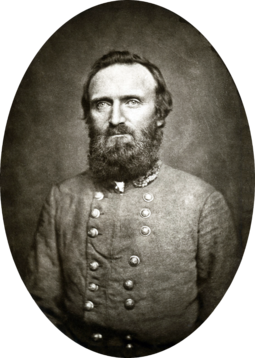Thomas Jonathan "Stonewall" Jackson
|
Lieutenant general Thomas Jonathan Jackson |
|
|---|---|

General Jackson photographed at Winchester, Virginia 1862
|
|
| Nickname(s) | "Stonewall", "Old Jack", "Old Blue Light", "Tom Fool" |
| Born |
January 21, 1824 Clarksburg, Virginia, U.S. (now Clarksburg, West Virginia) |
| Died | May 10, 1863 (aged 39) Guinea Station, Virginia |
| Buried at | Stonewall Jackson Memorial Cemetery Lexington, Virginia, U.S. |
| Allegiance |
|
| Service/branch | |
| Years of service |
|
| Rank | |
| Commands held | |
| Battles/wars | |
| Signature | |
Mexican–American War
American Civil War
Thomas Jonathan "Stonewall" Jackson (January 21, 1824 – May 10, 1863) was a Confederate general during the American Civil War, and the best-known Confederate commander after General Robert E. Lee. His military career includes the Valley Campaign of 1862 and his service as a corps commander in the Army of Northern Virginia, under Robert E. Lee. Confederate pickets accidentally shot him at the Battle of Chancellorsville on May 2, 1863. The general survived but lost an arm to amputation; he died of complications from pneumonia eight days later. His death was a severe setback for the Confederacy, affecting not only its military prospects, but also the morale of its army and of its general public. Jackson in death became an icon of Southern heroism and commitment, and became a mainstay in the pantheon of the "Lost Cause".
Military historians consider Jackson to be one of the most gifted tactical commanders in U.S. history. His Valley Campaign and his envelopment of the Union Army's right wing at Chancellorsville are studied worldwide, even today, as examples of innovative and bold leadership. He excelled as well in other battles: the First Battle of Bull Run (First Manassas), where he received his famous nickname "Stonewall"; the Second Battle of Bull Run (Second Manassas); and the battles of Antietam and Fredericksburg. Jackson was not, however, universally successful as a commander as displayed by his late arrival and confused efforts during the Seven Days Battles around Richmond, in 1862.
...
Wikipedia
